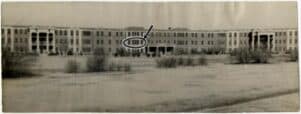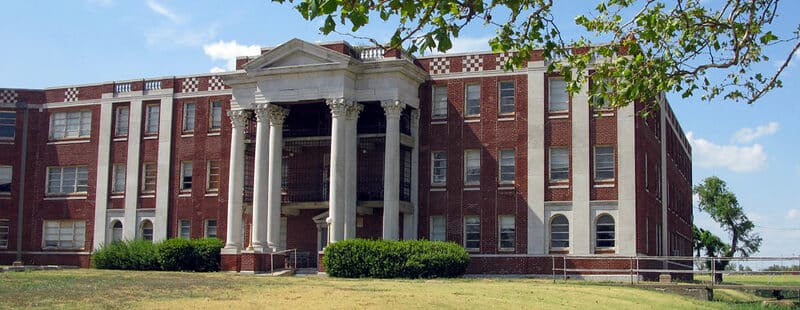| City/Town: • Norman |
| Location Class: • Hospital |
| Built: • 1928 | Abandoned: • 2012 |
| Historic Designation: • Abandoned Atlas Foundation Contribution to POK Most Endangered List (2022) |
| Status: • Abandoned • Private Property |
| Photojournalist: • Gary Henry |

The building that would become Hope Hall got its start almost a century ago in 1928 when bids were being taken to construct a new building at the Central State Hospital in Norman, Oklahoma to be used as a men’s receiving ward. Quickly growing and expanding Hope Hall got an East wing addition a few short years later, the contract for construction was given to Bailey and Burns Construction Co. At any given time nearly thirty men were working on the addition that would become the women’s receiving ward. Construction was completed within the year and the capacity for Hope Hall was around five hundred beds. By 1937 it had become the ward for veterans who struggled with mental health issues and PTSD.
Unlike any other facility of its kind in the South, Hope Hall was built for approximately $1,000,000. Accompanying the veterans it was big enough and secure enough that it also housed those deemed criminally insane. The most violent of them all were held in this facility, to ensure the utmost safety bars were placed around some of the high-risk areas to prevent those from escaping and or jumping. It was not even twenty years later that Hope Hall underwent a $375,000 remodeling by the Manhattan Construction Co. It consisted of a new women’s dining room, remodeling of wards 1, 2 and 3. Something to remember is back then the way that mental illness was treated, and perceived is very different from how mental illness is perceived and treated today. Some of the treatments that were used included water therapy, electric compulsive therapy (ECT), lobotomies, recreational therapy, and group therapy.
During the de-institutionalization that started to spread throughout Oklahoma’s state hospitals in the fifties, the Central State Hospital began a new era. It then was renamed Griffin Memorial Hospital in 1953, and by the 1990s the state facilities around the state were all struggling to stay afloat. Insurance companies had begun to cut the time it took to treat the mentally ill from long term to short term and covered less of their care. One by one the huge campuses that use to house hundreds of people were down to only a few dozen. The need for a whole campus of buildings wasn’t needed anymore, the Griffin Memorial Chapel closed on the grounds as well. It then became an administration building in the 2000s.
By 2012 the historic and stoic Hope Hall closed, no longer being needed for its services and facilities. But a few years after its closure the public was given the chance to tour the building for the first and only time to commemorate its centennial as a state-operated facility. The tour took guests through the facility providing a look at what it was like to be a patient and go through the admitting and treatment process. Each individual that attended was given a small, paper cup that contained papers that had symptoms on them. They were given a diagnosis and showed how some of those patients back then would have been treated with that diagnosis. They aimed to break the stigma of mental health treatment facilities by allowing the tour. Hope Hall now sits empty and vacant deteriorating more and more with the passing years.
This location is heavily patrolled and monitored, those caught trespassing will be prosecuted.
Gallery Below of Hope Hall Griffin Memorial
[Photograph 2012.201.OVZ001.4963], photograph, 1936; (https://gateway.okhistory.org/ark:/67531/metadc1697579/: accessed February 5, 2021), The Gateway to Oklahoma History, https://gateway.okhistory.org; crediting Oklahoma Historical Society.
“12 Mar 1937, 1 – Payne County News at Newspapers.com.” Newspapers.com, www.newspapers.com/image/660682504/?terms=hope%20hall%20norman&match=1.
“16 Sep 1951, 49 – The Norman Transcript at Newspapers.com.” Newspapers.com, www.newspapers.com/image/700422109/?terms=construction%20hope%20hall%20norman&match=1.
“30 Jul 1931, 1 – The Norman Transcript at Newspapers.com.” Newspapers.com, www.newspapers.com/image/699455312/?terms=construction%20hope%20hall%20norman&match=1.
“31 Jul 1931, 1 – The Norman Transcript at Newspapers.com.” Newspapers.com, www.newspapers.com/image/699455425/?terms=construction%20hope%20hall%20norman&match=1.
“8 Dec 1949, 1 – The Norman Transcript at Newspapers.com.” Newspapers.com, www.newspapers.com/image/700423217/?terms=construction%20hope%20hall%20norman&match=1.
https://rs.locationshub.com/location_detail.aspx?id=024-10032958
https://www.normantranscript.com/news/local_news/tours-provided-of-abandoned-psych-ward-for-100-years-of-mental-health-treatment/article_7ec785f3-7ff2-5a59-a867-b7b01a948708.html#:~:text=Griffin%20Memorial%20Hospital%20provided%20tours,as%20a%20state%2Doperated%20facility.
If you wish to support our current and future work, please consider making a donation or purchasing one of our many books. Any and all donations are appreciated.
Donate to our cause Check out our books!

































































































No it is private property and tresspassing is strongly discuraged because the building is full of asbestus, toxic mold and colapseing interior
I currently work there that is how I know .
I am in the Museum Studies masters program at OU and would like to take archival photographs and video of the interior and exterior. I am willing to sign whatever liability wavers are needed to preserve such an integral part of the city’s history. Is this a possibility?
It is not, we have already offered all liability forms written by our attorney etc etc. These were taken by a former worker on the one day they allowed the building to be toured in 2015. They have and will not allow anyone in since, especially after the significant fire damage making it even more dangerous.
Is it possible to get permission to explore this beautitful place?
Is This still around?
Yes it is!